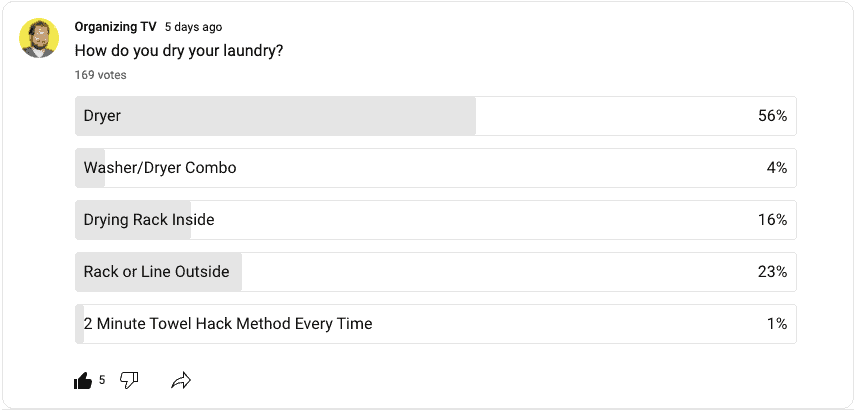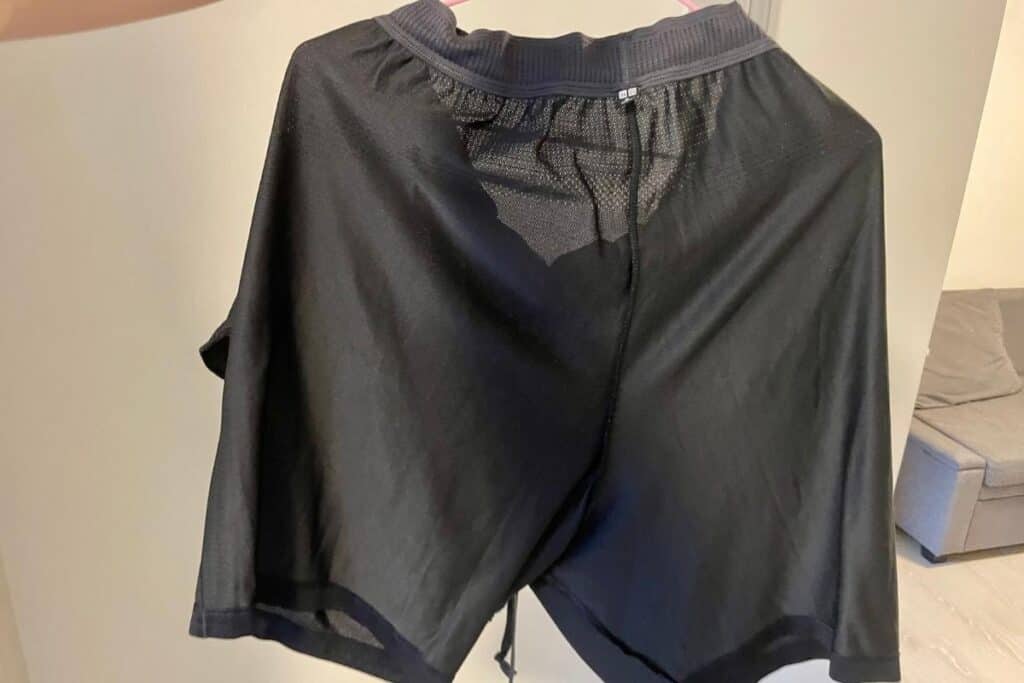Line drying your clothes is a natural method that can make you feel like you are wearing sunshine.
Knowing how to line dry clothes is a life skill that used to be passed along from one generation to the next. With the rapid rise in the popularity of dryers, the knowledge of how to hang our clothes on a line to dry naturally has faded. Line drying clothes is pretty basic if you do it methodically and follow some basic steps.
Clothes can be line dried by following these simple steps:
- Check if line drying is allowed
- Decide where the line will be
- Wipe the line
- Use the right pegs
- Prepare the wet clothes
- Hang the garments correctly
- Watch the weather
- Remove and fold clothes
- Try Lazy Lining
Fortunately, line drying clothes is making a comeback as eco-friendly living is being embraced. If you were one of the generations who was raised putting everything in the dryer, help is at hand, and soon you will be able to confidently line dry your clothes without tell-tale stretchy peg-bumps. Watching your clothes dry naturally in the open air can feel lovely, and you will feel the difference when you wear them again.

How To Line Dry Clothes
We all know the feeling of taking clothes out of the dryer and finding that they have tangled up and need to be untwisted. Fortunately, this is a challenge that you will never know again if your clothes can flutter freely on an airy line rather than being super-heated in a metal drum.
While there are drawbacks to line drying clothes outside, like sudden weather changes or your neighbor starting up his barbeque, there are huge benefits to your clothes and the environment. Line drying is far gentler on your clothing which means they will last longer.
Garments that contain elastic-like underwear can perish when they are repeatedly subjected to high temperatures. Line drying them is sure to extend the life of your favorite undies!
Tumble dryers are also heavy consumers of electricity. Line drying will most definitely reduce your power bill by up to 8%. So besides your clothes lasting longer and having a lovely air-dried scent to them, you will also be saving money and sparing the environment.
There are a few simple steps that one needs to follow to line dry clothes properly. Anyone can just fling a pile of wet washing items over a line, but learning to do it right so that your clothes come off the line dry, without peg marks, and needing minimal ironing is the goal.
Let’s check the steps involved to line dry clothes.
1. Check If Line Drying Is Allowed In Your Area
Check that it is allowed in your area before you enthusiastically start stringing up a washing line across your yard. Weird as this may sound, some towns, cities, and Home Owners Associations in the USA have laws that make line drying clothes illegal. Their reasoning for this is that it can look unsightly for everyone to be displaying their undies openly, which will lower the tone of their neighborhoods.
If you live in one of the areas where line drying your clothes is not permitted, do not despair. There are some ways of getting around this, like using a clothes drying rack (Amazon paid link). While it may not be an old-fashioned washing line, you can still enjoy the air-dried freshness on your clothes and keep your undies in mint condition.
Clothes drying racks are also useful when the weather doesn’t allow for line drying. Keeping a drying rack near a heating vent works well, and clothes dry this way quickly without consuming any additional power.
Using less energy means saving fossil fuels which reduce pollution. Your clothes also last longer, so that will also be an environmental win. So let’s get started on our laundry!
2. Line Dry Clothes In The Perfect Spot
If you want to put up a permanent outdoor clothesline, first check out the available options. Under no circumstances should you just use any line, or even worse, a wire that you have available to work as a wash line. To keep your clothes clean and free of marks, clotheslines must have a protective coating of vinyl or PVC that won’t leave marks on your clothes while drying.
Clotheslines come in many designs, and you should select one that will fit neatly and discretely in your yard and still be big enough to hold the family’s washing. It should also be fairly close to the house so that taking it out to hang up isn’t a hassle.
Basic, long, old-fashioned clotheslines are available if you have a lot of space. Choose something sturdy like the Strata Clothes Line Kit (Amazon paid link). It comes with metal pulleys and a winch so that you can secure the line tightly to hang even the heaviest items without sagging.
If space is a constraint, you can use a retractable clothesline (Amazon paid link). These are great if you have kids that play outside and know that an umbrella-type clothesline (Amazon paid link) will be too much of a temptation!
Your clothesline needs to get as much sun as possible. It shouldn’t be under any trees where birds perch or close to any area where a lot of dust gets kicked up, like a dirt road.
Out in open air, in the full sun, is the sweetest spot for a washing line. The sight of your clothes and linen flapping gently in the breeze as it dries naturally is not only good for the clothes, it will also give you a warm homely feeling.
3. Wipe Down The Line Before Line Drying Your Clothes
Before you hang any clothes on a clothesline, it is important to ensure that the line is clean. Dirt and debris in the air can collect on the line and transfer onto your clean laundry when you hang it up.
Unless your clothesline is the retractable type that has been safely rolled up and stored away, you can just use any soft, damp cloth and quickly run it over the length of the washing line. This small step will ensure that you can confidently line dry even your white garments.
4. Use The Right Pegs When Line Drying Your Clothes
There are many types of clothes pegs available. They come in different colors, materials, sizes, and each type is marketed with special features. As someone who has done laundry a lot, the basic wooden pegs (Amazon paid link) work best and last the longest. Over time, the large plastic varieties tend to become brittle from being exposed to direct sunlight. Once they break, they can’t be fixed and must be thrown away.

Wooden pegs may look basic, but they have stood the test of time. They are easy to put back together if they occasionally twist apart. They are also a lot more environmentally friendly than the plastic types, so if you have moved to line drying your clothes to reduce your carbon footprint, then wooden pegs are the way to go.
Regardless of what sort of pegs you decide to use when you line dry your clothes, they must be stored inside and not left on the washing line between uses. This will keep them free from any mold or dirt that they may be exposed to if left out on the washing line for long periods.
5. Prepare The Wet Clothes Before Line Drying
When you do your washing, try not to pack the machine too full. If items are jammed into the drum, they tend to come out extra crinkled, which will transfer to the line. Also, line drying can take longer than a dryer, so if you do multiple loads on one day, begin with the heaviest items like towels or heavy fabrics like jeans. These will take longer to dry than thin fabrics like T-shirts and undies.
Before you peg any item to the clothesline, be sure to give each one a vigorous shake. Not hard enough to damage or stretch the item, but enough to remove any extra-large creases. While the items are damp from the wash, it is easier to shape them than trying to flatten them after they have dried.
Ensure that seams and hems or any specific area on any item that tends to roll are flattened before hanging it up. It will make folding or ironing the item a lot easier.

If the item of clothing is a bright color or black, it is a good idea to turn it inside-out before hanging it out in the sun. This will reduce the chance of the color fading. Whites can be left the correct way around because sunlight makes them brighter.
6. Hang Items Correctly When Line Drying Clothes
The way you hang your clothes on the clothesline is going to be evident when you remove them. If you peg a T-shirt by the shoulders, be prepared to have a tiny peg stretch mark on the top of each should when you take it off.
Knowing HOW to hang items on a clothesline to avoid peg marks and so that they will dry thoroughly is probably the most important aspect of line drying clothes. Before you even start hanging the clothes up, have a plan in mind about what order you want them to come down. Hang a particular person’s items together in a group or all the items from a particular closet.
As you fill your basket while you are taking laundry down, it saves time if the items are grouped together so you can deliver batches to specific spots without having to dig through the entire basket in each room. Hang the clothes on the washing line accordingly.
How To Peg Clothing Items To A Washing Line
There are some old tried and tested ways to hang some everyday clothes items on a clothesline to dry quickly and don’t get peg marks in conspicuous places.
Jeans: heavy fabric trousers like jeans must hang from the waistband. Fold over the top of the waistband at the back and secure it to the line using three pegs. A middle one will just give the pants a bit more security as it is heavy fabric.
Pants: For pants that are not heavy like denim, and need some shape, hang them from the bottom hems. Line the trouser legs up to encourage any intentional seams in the fabric, and then peg them to the line on the hems inside the legs.
T-shirts: Always hang T-shirts upside down. There is no exception unless you hang them onto hangers that you put on the line to dry. T-shirt fabric tends to stretch a tiny bit where pegs hold them. If you hang them upside down and fold the hem over the washing line, this will not be a problem.
Underwear: Hang by the back waistband. One peg will easily hold each item.
Socks: To avoid the strange one-lost-sock phenomena which no one has ever solved, try to match socks before you hang them up. Hang them in pairs from their toes ends.
Button-down shirts: Hang them upside down from the hem. These shirts usually dry quickly.
Dresses: Be careful when you line dry dresses because you must not create any lumps or bumps on the fabric, even on the hem. I would recommend that you hang dresses on hangers to have good support without pulling on any area. Then hang the hanger with the dress on the line.
Skirts: Skirts can usually hang from the waistband like jeans. Turn the skirt inside out and peg the back of the waistband over the line.
Heavy garments: Items such as sweaters should usually be dried flat, and I don’t recommend that they get pegged onto a clothesline. You would use a clothes rack inside to drape the garment over several racks to retain its shape perfectly.
Towels and linen: Taking your fresh towels and sheets off an outside clothesline is one of the best feelings. They feel so fresh, and you will be excited to use them, knowing that they have been dried naturally by the sun. However, towels are thick and may take a little longer to dry than some of your other items.
Do not fold towels double over a clothesline and peg them down. This creates peg marks right in the middle of the towels where they will be most noticeable, but it will also increase the time needed to dry them. Instead, just fold the top section of towels over a clothesline and peg it down securely using more than two pegs. That will allow the air and sun to reach the entire towel and dry much faster.
7. Watch The Weather When Line Drying Clothes
Drying your clothes outside in the fresh air and sunshine is great. One of the only drawbacks is that they will get wet if there is a sudden downpour, so keep an eye on the weather when you hang your laundry out. You will have to start again if your clothes were dry on the line but got soaked in a later afternoon shower.
8. Removing Clothes From A Clothes Line
As you take washing off the line when it is dry, give each item a proper shake to remove any creases. Then fold the items immediately into the shape that they will be stored in.
Have some hangers with you to hang the dress-shirts or skirts, so they don’t get creased from being folded into a laundry basket. Shake towels vigorously before folding, and roll sock together immediately so you don’t have to re-sort and search for matches later.
Collect the pegs together so that they can be stored inside the laundry room.
Try Lazy Lining To Line Dry Clothes
If you don’t feel confident about hanging garments on a clothesline, or you want to save time taking them down, you can try lazy lining them. All this means is that instead of attaching clothes to the line using pegs, you hang them on plastic hangers, and the entire hanger is suspended from the washing line.
This method is highly recommended for garments like dresses and dress shirts. If you are using it for T-shirts, be sure that the hanger is long enough to extend the full length of the shoulders so that the T-shirt doesn’t develop a crease on either side of the neck.
This method will save you time later when you take the laundry down. You may still have to use pegs to keep the hangers spaced apart while the clothes are trying, and of course, for your small items.
Conclusion
Line drying clothes is far gentler on your garments, and they will last longer than if they are constantly tumble-dried. It is also a small step that we can all take to start embracing a more natural lifestyle, reduce our energy consumption and help to save our planet. The best thing about line drying clothes is that you will be able to smell the lovely fresh, sunny scent on all your clothes long after you take them down.

I’m an expert wardrobe organizer and a bit of a clean freak. I created this website and its YouTube channel to share practical guides about laundry and organizing. My teachings have been featured in multiple large news publications, and I’ve self-published two wardrobe organizing books and an entire course on the subject.
